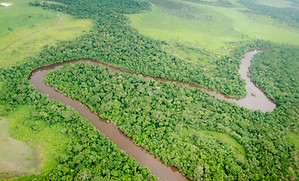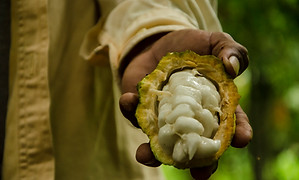
Origin of Chocolate
Cacao is a tropical fruit, meaning that it can only be found in areas located between the tropics of Cancer and Capricorn. It needs an average of 1500 to 2000 mm of water annually and temperatures around 33ºC (91ºF) to grow.
It is a perennial tree and its biological origin is the Amazonian Savannah, an area part of the fluvial chain feeding the great Amazonas River.


The dissemination of this species -Theobroma Cacao- to Center and North America was due to the translation of its seeds by animals like monkeys and parrots among many others. One theory suggests that it was spread through Orinoco river continuing later its dispersion until it was found and cultivated by Mesoamerican cultures, in the territory today known as Mexico, where it was later discovered by the Spanish expeditions.



How Cacao became Chocolate
The first records of cacao history leads us to America´s discovery by the Spanish and their arrival to the coasts of Mexico, where the natives used to cultivate it much longer ago.
There is a rich amount of information regarding the importance of cacao for Mesoamerican cultures.
Cacao was used in the Maya culture to prepare a beverage named “Xocolatl” made from cacao beans mixed with other species and water.
They believed that this mixture was a powerful food and they used to drink it during spiritual ceremonies. This is how the so-called “Food of The Gods” qualification appeared.
When the Aztecs conquered The Mayan territories, they kept and spread the value of Theobroma cacao given by those.
The historical narrative tells that due to the cultural value and its shortage, cacao was also used as currency.
It is told that Christopher Columbus was the first European to try “Xocolatl”, but it was Hernán Cortez who brought it there, about 1530. The physical “Theobroma cacao” was among many other marvelous goods taken to European lands .
Although it was not a tasty food at the beginning, due to its bitterness and astringency, it was presented in Courts and Royal Palaces in most parts of Europe. Here it promptly became popular and began to be mixed with other ingredients as sugar and other species to make it more tasty. As it was a limited and exclusive good, its consumption was destined for the aristocracy only.
The popularity of cacao as an ingredient in many European countries, made an impact on the cultivation of cacao, especially in tropical territories under domination of the powerful kingdoms of Spain, Holland and Great Britain.
The road to transform cacao into the delicious mixture today known as chocolate started in 1728 when Walter Churchman developed a steam machine used to break seeds.


In 1828 Van Houten invented a screw press to separate the cacao butter from the cacao beans resulting later in the discovery of cacao powder.
Around 1847, Francis Fry mixed sugar with cacao butter and cacao paste and since then innovations and technological discoveries have since contributed to thousands of incredible ingredient combinations resulting in our worldwide beloved Chocolate.
Nowadays, more than 50% of worldwide cacao cultivation comes from North Western African countries, led by The Ivory Coast, Ghana, Cameroon and Nigeria, followed by South and Central American countries like Brazil, Ecuador, Peru and Nicaragua.
As in the 16th century, cacao is still a limited resource and big companies have pushed its cultivation in countries considered new producers such as Indonesia, The Philippines, Vietnam, Madagascar and India.
North European countries are considered the fathers of chocolate science, since it was here not only the chocolate production originated, but also where the development of technology to transform cacao into chocolate took place.

